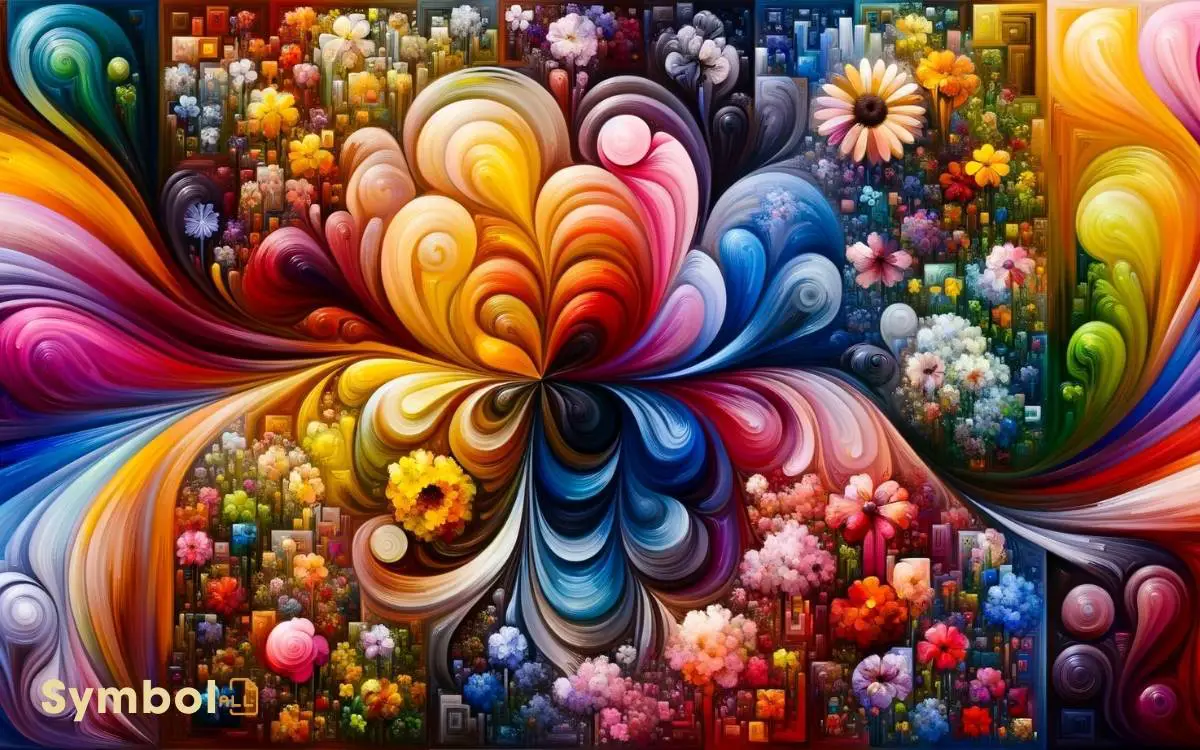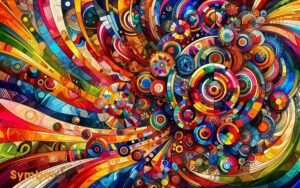What Colors Symbolize in Flowers? Red, Orange, Yellow!
You’re stepping into a world where colors speak. Red flowers, with their vibrant hues, ignite your emotions, symbolizing deep passion and courage.
Orange blossoms boost your creativity, oozing enthusiasm and endless energy.
Yellow petals, like rays of sunshine, embody friendship and joy, enhancing your mood and cognitive abilities.
Greens signify growth and renewal, connecting you to nature’s cycle. Blue’s serene presence brings tranquility, fostering trust and wisdom. Purple flowers tell stories of admiration and respect, while pink whispers of love and gratitude.
White blooms, pure and untouched, symbolize innocence and new beginnings. Diving deeper reveals deeper mysteries of color symbolism in flowers.

Key Takeaways
12 Colors Flower Meaning and Symbolism
| Color | Flower Symbolism | Common Flowers |
|---|---|---|
| Red | Love, Passion, Respect | Red Roses, Red Tulips |
| Yellow | Friendship, Joy, Get Well | Sunflowers, Yellow Daisies |
| Pink | Happiness, Gentleness, Admiration | Pink Roses, Pink Carnations |
| White | Purity, Sympathy, Innocence | White Lilies, White Roses |
| Purple | Dignity, Pride, Success | Lavender, Purple Orchids |
| Blue | Peace, Tranquility, Trust | Bluebells, Hydrangeas |
| Orange | Enthusiasm, Energy, Warmth | Orange Marigolds, Tiger Lilies |
| Green | Life, Growth, Health | Green Chrysanthemums |
| Lavender | Elegance, Refinement, Grace | Lavender Herb, Lilacs |
| Peach | Modesty, Sincerity, Gratitude | Peach Roses, Snapdragons |
| Black | Farewell, Mystery, Elegance | Black Roses, Calla Lilies |
| Mixed Colors | Joy, Celebration, Happy Life | Mixed Floral Bouquets |
The Passion of Red
Red isn’t just a color; it’s the embodiment of passion and vitality, commanding your attention with its bold presence in the floral world. When you gaze upon a red flower, you’re not just seeing a hue; you’re witnessing a powerful symbol of love and courage.
This isn’t happenstance. Scientifically, red pigments in petals absorb light in a way that deeply engages our emotions, triggering reactions that resonate with ardor and strength.
Additionally, red flowers are evolutionary marvels, developed to attract pollinators with their vibrant allure. They stand as beacons of desire and resilience, drawing in both admirers and essential insects.
In the language of flowers, red’s message is unmistakable: it speaks of deep affection and boldness, reaching out to touch your heart with its fervent whispers.
Orange and Enthusiasm
As you explore the vibrant world of orange blooms, you’ll find they symbolize enthusiasm and energy, infusing gardens with a sense of perpetual joy.
This energizing hue impacts your mood, boosting creativity and fostering an environment where warmth and innovation thrive.
The connection between orange flowers and creativity isn’t just aesthetic; it’s rooted in the science of color psychology, demonstrating how these lively shades can invigorate and inspire.
Symbolism of Orange Blooms
In the vibrant world of floral symbolism, orange blooms stand out as emblems of enthusiasm and energy, mesmerizing observers with their vivid hues and dynamic presence.
Delving into their rich palette, you’ll find that these flowers are not merely decorative elements but carry profound meanings across various cultures.
They symbolize a bridge between the warmth of red and the joyfulness of yellow, crafting a visual and emotional spectacle of passion, creativity, and vitality. They evoke a sense of energy that is both grounding and exhilarating, linking emotions to seasonal transitions and cultural expressions. Particularly during autumn, these hues take on a deeper significance, with Halloween colors symbolism explained through their connection to themes of transformation, mystery, and festivity. The interplay of such colors stirs a vibrant narrative that resonates with nature’s rhythms and the human spirit’s desire for connection and celebration.
| Flower | Symbolism |
|---|---|
| Orange Rose | Fascination, Passion |
| Marigold | Warmth, Optimism |
| Zinnia | Remembrance, Friendship |
| Dahlia | Grace under Pressure, Change |
In this tableau, each orange flower whispers tales of ambition and boundless energy, inviting you to grasp the unspoken language of flora.
Energizing Hue Impact
Building on the vibrant symbolism of orange blooms, let’s explore how their energizing hue impacts our feelings of enthusiasm and energy.
When you gaze upon an orange flower, its vivid color immediately interacts with your visual perception, triggering a cascade of psychological responses.
Scientifically, colors profoundly influence human emotion and behavior, with orange standing out as particularly stimulating. This hue’s psychological effect is linked to increased oxygen supply to the brain, sparking invigorating feelings of excitement and vitality.
It’s no coincidence that orange flowers often grace joyous occasions, embodying a sense of enthusiasm and an energetic atmosphere.
Their presence can subtly elevate our mood and enhance our engagement with the surroundings, proving nature’s capability to influence our emotional state through color.
Creativity and Warmth Connection
Delving deeper into the spectrum of orange’s influence, we discover its powerful connection to fostering creativity and radiating warmth, which, in turn, amplifies our feelings of enthusiasm.
This vibrant hue, found in nature’s blooms, embodies a blend of invigorating energy and comforting embrace that encourages creative expression.
- Stimulates Mental Activity: Boosts cognitive functions, leading to innovative thinking.
- Enhances Social Interaction: Invites open communication and collaboration.
- Fosters Emotional Strength: Builds resilience and optimism in facing challenges.
- Inspires Bold Choices: Encourages risk-taking in artistic endeavors.
- Radiates Positivity: Cultivates a welcoming atmosphere that nurtures creativity.
Understanding orange’s role in stimulating creativity and warmth reveals its importance in not just floral aesthetics but also in enhancing human experiences of enthusiasm and collaborative energy.
Yellows Warmth
You’ll find that yellow flowers embody the warmth of the sun, influencing your emotions and mood in profound, uplifting ways. It’s no coincidence they’re seen as the universal color of friendship, symbolizing bonds that endure through time.
This hue’s ability to evoke joy and connection is rooted in both scientific research and cultural traditions, making its presence in nature deeply significant.
Sunshines Emotional Impact
The warmth of yellow hues, often linked with sunlight, can greatly uplift your mood by stimulating feelings of happiness and energy. This emotionally positive impact isn’t just anecdotal; it’s deeply rooted in psychological and physiological responses to the color yellow.
- Increases Alertness: Yellow captures attention and promotes alertness, enhancing cognitive function.
- Stimulates Serotonin: Exposure to yellow can increase serotonin levels, boosting your mood.
- Encourages Communication: Yellow’s vibrancy encourages open and optimistic communication.
- Enhances Creativity: This color can stimulate your creative juices, making you more innovative.
- Boosts Energy: Just like natural sunlight, yellow tones can invigorate you, making you feel more energetic and lively.
Understanding these effects can deepen your appreciation for yellow flowers, recognizing them as more than just visually pleasing they’re mood-enhancing companions.
Friendships Universal Color
Embracing yellow’s warmth, you’ll discover it’s universally acknowledged as the color of friendship, radiating joy and fostering connections among people.
This vibrant hue, found in flowers like sunflowers, daffodils, and roses, isn’t just a feast for the eyes. It carries deep symbolic meaning, intricately woven into the fabric of human emotions and relationships.
Scientifically, yellow’s wavelengths stimulate feelings of happiness and warmth, mirroring the essence of strong, enduring friendships. In the natural world, these blooms serve as beacons of positivity, encouraging mutual support and understanding.
Green for Growth
Often, green petals in flowers signify vigorous growth and a robust photosynthetic activity, essential for a plant’s development and energy production.
This color, embodying the essence of nature, encapsulates the relentless pursuit of life towards sunlight, converting it into the energy that fuels all living ecosystems.
- Chlorophyll Domain: Green flowers exhibit a high concentration of chlorophyll, crucial for photosynthesis.
- Symbol of Renewal: They represent new beginnings and the rejuvenation of life.
- Fertility Indicator: Green in flora often signals fertility and the rich potential for new growth.
- Adaptability: Shows a plant’s adaptability to various light conditions, optimizing energy absorption.
- Eco-Connection: They remind us of our deep, intrinsic connection to the natural world, urging sustainability and conservation.
This color’s scientific significance and its passionate reminder of growth’s importance make it a profound symbol in the botanical area.
The Calm of Blue
Shifting our focus to the serene hues of blue, you’ll find these colors in flowers evoke a sense of tranquility, mirroring the sky and sea in their peaceful beauty.
Delving into the science, blue pigments in flowers, such as delphinidin, absorb specific wavelengths of light, showcasing a spectrum of blues that can calm the mind.
This color’s rarity in the natural floral world adds to its mystique, symbolizing trust, loyalty, and wisdom.
Culturally, blue flowers are cherished for their soothing presence, often used in environments requiring calmness and concentration. Their presence in a garden or bouquet brings a breath of calm, reminding you of nature’s ability to soothe the soul.
Blue’s ability to lower heart rates and reduce appetite further underscores its tranquil essence, making it a genuinely remarkable color in the floral world.
Purples Royal Touch
Entering the domain of purple flowers, you’ll uncover their vibrant shades demand attention, symbolizing royalty, nobility, and luxury with a scientific and passionate depth that’s as enchanting as their history.
These hues offer a visual feast, deeply rooted in a rich tapestry of cultural and botanical significance.
- Anthocyanins: The pigments responsible for purple’s vivid color, showcasing nature’s chemistry at work.
- Lavender: Symbolizes serenity, grace, and calmness, reflecting its delicate appearance.
- Orchids: Represent admiration and respect, carrying a mystique in their exotic beauty.
- Violets: Embody loyalty and faithfulness, with a heritage steeped in ancient mythology.
- Lilacs: Denote confidence and youthfulness, evoking spring’s first bloom’s fresh, optimistic promise.
Each flower tells a story, where purple reigns with a dignified elegance, inviting you to explore further into its royal palette.
Pink and Affection
As you explore the enchanting world of pink flowers, you’ll find that pink roses symbolize a deep expression of love, their hues capturing the essence of heartfelt emotions.
Carnations, especially in pink, serve as the quintessential Mother’s Day gift, embodying gratitude and admiration towards maternal figures.
Meanwhile, peonies offer a lush representation of prosperity and romance, their opulent petals and rich coloration speaking volumes about affection and well-being.
Pink Roses: Loves Expression
Often symbolizing love and admiration, pink roses beautifully express affection with their delicate hues and intricate petal structure. These blooms, cultivated for centuries, carry deep emotional meanings, and their color variations add depth to their symbolism.
From pale blush to vibrant cerise, each shade conveys a unique message of care, gratitude, and joy.
- Pale Pink: Signifies grace and gentleness, perfect for new relationships.
- Deep Pink: Represents gratitude and appreciation, ideal for saying thank you.
- Coral Pink: Exudes warmth and happiness, connecting hearts.
- Hot Pink: Embodies boldness and energy, a vibrant declaration of affection.
- Dusty Pink: Captures nostalgia and memory, symbolizing enduring love.
In the language of flowers, pink roses articulate the nuances of love with elegance and precision, making them a timeless choice for expressing heartfelt emotions.
Carnations: Mothers Day Icon
Carnations, a Mother’s Day staple, embody the deep affection and gratitude we hold for our mothers with their vibrant pink hues and rich symbolism.
This iconic flower, with its ruffled petals and sweet fragrance, has long been a symbol of a mother’s undying love.
Scientifically known as Dianthus, which translates to ‘flower of the gods,’ carnations carry a weight of history and significance.
The choice of pink specifically resonates with feelings of tenderness and admiration, making it the perfect gesture of appreciation.
In the language of flowers, pink carnations express the sentiment, ‘I will never forget you,’ underscoring the enduring bond between mother and child.
This Mother’s Day, when you opt for pink carnations, you’re not just giving a flower; you’re conveying a heartfelt message woven with centuries of tradition and emotion.
Peonies: Prosperity and Romance
Embodying both prosperity and romance, peonies, especially in pink, capture your heart with their lush, full blooms and rich historical significance. These flowers aren’t just a feast for the eyes; they’re steeped in meaning and science.
- Pink Peonies: Symbolize love, honor, and happiness.
- Layers of Petals: Reflect the complexity and depth of relationships.
- Bloom Lifespan: Their transient beauty reminds us of the fleeting nature of affection.
- Cultural Significance: In China, peonies are known as the flower of riches and honor.
- Botanical Aspect: Peonies thrive in cold climates, showcasing resilience and the ability to prosper under challenging conditions.
Understanding peonies enhances your appreciation for these flowers, highlighting their role in expressing emotions and celebrating life’s special moments.
Whites Purity
In the domain of floral symbolism, white flowers stand as a universal emblem of purity and innocence, capturing the hearts of observers with their serene beauty. This color’s association with purity isn’t arbitrary but deeply rooted in cultural and psychological contexts.
Scientifically, white reflects all wavelengths of visible light without absorption, symbolizing a blank slate or unblemished character.
This makes white flowers particularly significant in ceremonies like weddings, where they epitomize new beginnings and the pure union between individuals.
Furthermore, their presence in funerals speaks to the eternal purity of the departed soul, offering comfort in times of grief.
Understanding this, you’ll find that white flowers carry a profound message of hope, renewal, and unadulterated love, making them a powerful symbol in both celebratory and solemn occasions.
Black and Mystery
Exploring the enigmatic realm of black flowers, you’ll find they represent intrigue and grace with a depth unparalleled in the floral world.
These mysterious blooms, often perceived as symbols of the unknown, carry a richness of meaning that captivates the imagination and stimulates a deeper appreciation for nature’s subtleties.
- Black Roses: Emblematic of rebirth and farewell, challenging the traditional notions of beauty.
- Black Dahlia: Signifies a warning of betrayal, yet with an elegance that belies its dark message.
- Black Calla Lily: Represents sophistication and mystery, a favorite in avant-garde floral arrangements.
- Black Tulip: Symbolizes power and strength, offering a stark contrast to more vibrant species.
- Black Pansy: A symbol for free thought and independence, celebrating the diversity and complexity of the human mind.
Each black flower whispers secrets of a world beyond the visible, inviting you to explore the mysteries they hold.
Golds Luxury
Gold-hued flowers emit a lavish aura, mesmerizing your senses with their vibrant splendor and timeless elegance. Their golden petals aren’t just a delight for the eyes but also a symbol of wealth and prosperity.
In the botanical world, gold flowers like marigolds, sunflowers, and black-eyed Susans, carry a wealth of significance. They’re often associated with the sun’s life-giving energy, embodying optimism, happiness, and the pursuit of success.
Scientically, the pigments in these flowers reflect light in a way that gives them their luxurious golden hue, fascinating the observer and invoking a sense of awe.
Cultivating or gifting gold-hued flowers can signify a wish for abundance and enlightenment, making them a potent tool in both garden design and personal expressions of affection.
Silvers Sophistication
Silver-toned flowers bring an air of sophistication and mystery to any garden, enchanting onlookers with their unique allure and understated elegance.
When you incorporate silver-hued blooms into your garden, you’re not just adding plants; you’re weaving a tapestry of visual and emotional depth that speaks to the observer’s soul.
These colors aren’t just beautiful; they’re a demonstration of the adaptive strategies of flora in diverse environments.
- Reflectivity: Silver leaves reflect sunlight, reducing water loss in arid conditions.
- Temperature Regulation: Their reflective property also helps in cooling the plant.
- Pest Deterrence: Bright surfaces can deter certain plant-eating insects.
- Pollinator Attraction: Contrasts with other colors to attract specific pollinators.
- Evolutionary Advantage: Represents a unique adaptation to survive and thrive.
Silver-toned flowers embody resilience, showcasing nature’s ingenuity in the face of ecological challenges.
Browns Stability
Why do brown flowers exude a sense of stability and earthiness in a garden landscape?
When you explore the hues of brown, you’re engaging with a palette that mirrors the foundational elements of nature soil, wood, and stone. These elements embody resilience, enduring through seasons and providing a grounding presence.
Brown flowers, though less common, contribute to this narrative of steadfastness and reliability. They don’t chase the ephemeral beauty of more vibrant blooms but offer a subtle, enduring charm.
Scientifically, the pigmentation in brown flowers, ranging from deep chocolate to light tan, is a result of complex chemical processes, including the breakdown of chlorophyll and the presence of specific flavonoids and carotenoids.
These flowers remind you of the cycle of life, growth, and decay, anchoring the garden with their muted strength.
Multicolor and Diversity
Multicolored flowers, bursting with a spectrum of hues, epitomize the garden’s vibrant diversity and invite an exploration of genetic variation and ecological adaptation.
You’re witnessing nature’s palette at its finest, where each color plays an essential role in the survival and reproduction of these botanical wonders.
- Genetic Diversity: Multicolored flowers demonstrate the genetic complexity and adaptability within species.
- Pollinator Attraction: Diverse colors attract a broader range of pollinators, ensuring successful pollination.
- Ecological Adaptation: Color variations often signify adaptation to specific environmental conditions.
- Signaling Mechanisms: Multicoloration may serve as signals to potential pollinators about the availability of nectar.
- Evolutionary Advantage: Variability in coloration can be an evolutionary strategy to thrive in competitive ecological niches.
This kaleidoscope of colors isn’t just a feast for the eyes; it’s a reflection of the intricate dance of evolution and ecology.
Conclusion
In the tapestry of a garden, each flower’s color whispers its own tale. Like a painter’s palette, nature blends hues to convey emotions and messages.
Imagine a single red rose among greens, its vibrant passion standing out, a beacon of love in a sea of growth. This isn’t just aesthetics; it’s a language.
Research shows colors affect mood, proving how deeply intertwined we’re with nature’s chromatic symphony.
So, immerse yourself in this colorful journey, where every shade is a word, every hue a story.






